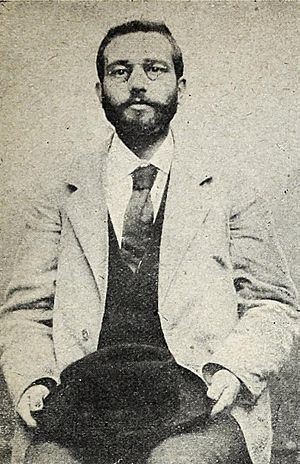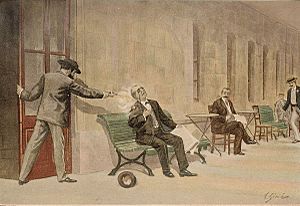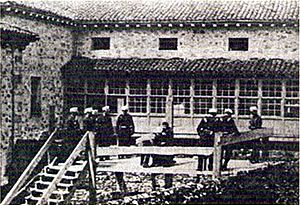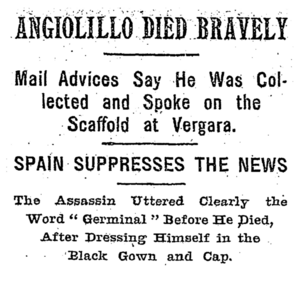Michele Angiolillo facts for kids
Quick facts for kids
Michele Angiolillo Lombardi
|
|
|---|---|

An image of Michele Angiolillo published in the Spanish magazine Blanco y Negro.
|
|
| Born | June 5, 1871 |
| Died | August 20, 1897 (aged 26) |
| Cause of death | Garrote |
| Nationality | Italian |
| Movement | Anarchism |
| Motive | Revenge for the Montjuïc trial |
| Criminal penalty | Capital punishment |
| Details | |
| Victims | Antonio Cánovas del Castillo |
| Killed | 1 |
| Weapons | Handgun |
Michele Angiolillo Lombardi (born June 5, 1871 – died August 20, 1897) was an Italian anarchist. He was born in Foggia, Italy. An anarchists is someone who believes in a society without government or rules.
Angiolillo is known for assassinating Antonio Cánovas del Castillo, who was the Prime Minister of Spain in 1897. Spanish authorities captured and executed Angiolillo in the same year.
Contents
Why Michele Angiolillo Acted
The Montjuïc Trial and Its Impact
On June 7, 1896, a bomb was thrown during a religious parade in Barcelona, Spain. This event was called the Corpus Christi procession bombing. At least twelve people died, and many more were hurt. Police blamed an unknown anarchist for the crime.
This bombing led to a harsh crackdown on people in Spain who believed in anarchism, communism, or socialism. This period became known as the Montjuïc trial. About 300 people were arrested and jailed at Montjuïc Fortress. Many were forced to confess to crimes they might not have committed.
Prime Minister Antonio Cánovas del Castillo himself ordered these harsh actions. News about the poor treatment of prisoners spread widely across Europe.
Out of 87 prisoners who went to trial, eight were sentenced to death. Five of these death sentences were carried out. Many others were sent to prison for a long time. The remaining prisoners were sent away to a Spanish colony called Río de Oro.
Angiolillo's Reaction to the Repression
At this time, Angiolillo was working as a printer in London. On May 30, 1897, he joined a large protest in Trafalgar Square. Over ten thousand people gathered to speak out against Spain's harsh treatment of workers' rights groups.
Many activists spoke at the protest, including Fernando Tarrida del Mármol and Charles Malato. Malato asked who would get justice for those who had suffered under Cánovas's rule.
After the protest, Angiolillo met two men, Oller and Francisco Gana. Both men had been badly injured from the harsh treatment they received under Cánovas's orders. A German anarchist, Rudolf Rocker, was also there. He later wrote about the meeting:
"That night when Gana showed us his crippled limbs, and the scars over his entire body left by the tortures, we understood that it is one thing to read about such matters, but quite another to hear about them from the very lips of the victims" ... "We all sat there as if turned to stone, and it was some minutes before we could utter a few words of indignation. Only Angiolillo said not a word. A little later, he suddenly rose to his feet, uttered a laconic goodbye, and abandoned the house" ... "This was the last time I saw him."
This meeting deeply affected Angiolillo.
The Assassination of Cánovas del Castillo



Michele Angiolillo traveled to Spain from London, using a false name, Emilio Rinaldini. He passed through Paris and Bourdeaux. When he arrived in Madrid, he learned that Prime Minister Cánovas was at a health resort in Mondragón. Angiolillo decided to follow him there.
On August 8, 1897, Angiolillo found Cánovas alone and shot him. The Prime Minister died. Cánovas's wife rushed to the scene, shouting at Angiolillo. Angiolillo bowed and said, "Pardon, Madame. I respect you as a lady, but I regret that you were the wife of that man."
Angiolillo later said he was not an assassin but an "executioner." He believed Cánovas was responsible for the harsh treatment at Montjuïc.
The New York Times newspaper wrote about Angiolillo:
Angiolillo allowed the authorities to capture him and vehemently denied other parties' involvement in the assassination. He was executed by garrote in the nearby town of Vergara.
Some people believe Angiolillo first planned to harm members of the Spanish royal family. However, a leader from Puerto Rico, Ramón Emeterio Betances, may have convinced him to target Cánovas instead. Betances also helped Angiolillo travel safely into Spain and gave him some money.
See also
 In Spanish: Michele Angiolillo para niños
In Spanish: Michele Angiolillo para niños

